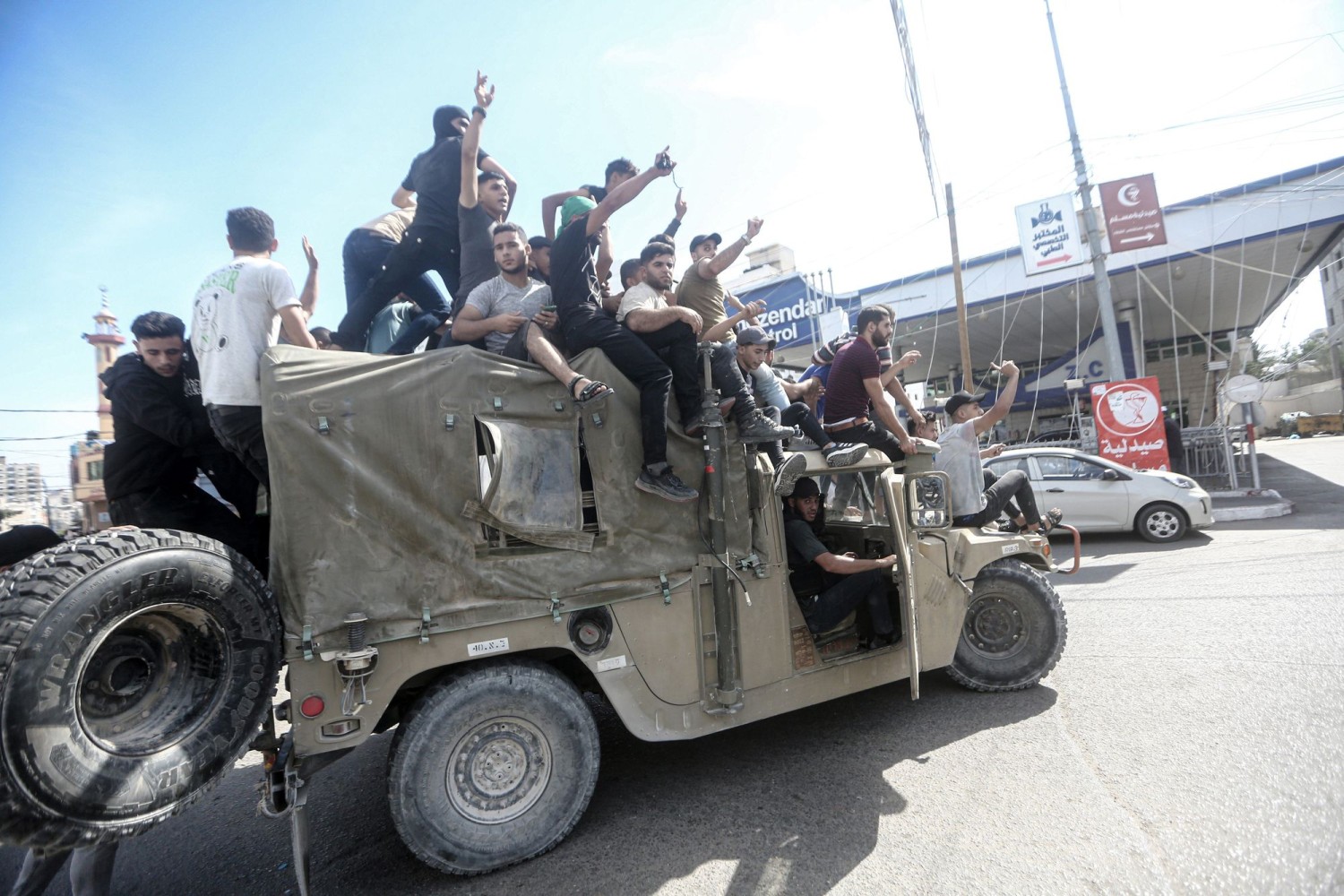
This article is more than
2 year old
TEL AVIV—Israel spent three years building a 40-mile-long, state-of-the-art, high-tech security barrier along the Gaza Strip, with radar and sensors designed to detect furtive incursions by Palestinians bent on carrying out covert attacks in Israel.
On Saturday, Hamas used bulldozers and other rudimentary means to punch through the 20-foot-high fence and flooded men through the gaps in pickups and on foot, a frontal assault on southern Israel that was the largest breach of the country’s borders since the 1973 Yom Kippur war.
It was a stark illustration of the limits to the Israeli military’s shift in focus to cyber capabilities, intelligence-gathering and advanced weaponry and its concentration on countering terrorist attacks. The armed forces were caught off guard by a relatively low-tech ground assault.
Now, the Israeli military is preparing for the possibility of a large-scale operation in Gaza, where it will have to rely more heavily on infantry and conventional artillery, areas deprioritized in recent years, and where it could be drawn into street-by-street fighting and urban warfare.
Israel’s military “has been preparing for the wrong war,” said Avi Jager, a researcher at the Israel-based International Institute for Counter-Terrorism.
Recent military attention was directed at the West Bank, where Israel deployed forces to quell a Palestinian militant insurgency. Israeli intelligence warnings of potential war had focused on the north and the threat from Hezbollah, Hamas’s Lebanese ally, military analysts said.


Until Saturday, Israeli officials widely believed a policy of boosting Gaza’s economy meant the leaders of Hamas, designated a terrorist organization by the U.S., Europe and Israel, had no interest in launching the kind of cross-border attack it staged.
At the same time, as the weekend’s events showed, Hamas has become more sophisticated. Saturday’s assault used a combination of missiles, naval vessels, drones and armed fighters who reached as far as the city of Ofakim, more than 20 miles inside Israel.
“Israel has suffered a strategic surprise, despite all its sophisticated high-tech, weaponry, spyware and world-renowned intelligence agency,” said Daniel Levy, a former Israeli peace negotiator with the Palestinians and president of U.S./Middle East Project, which works to resolve the Israel-Palestinian conflict. “Israel cannot keep its people safe anymore—and that will be hard to recover from.”
A spokesperson for the Israeli military said the armed forces are focused on prevailing in the current conflict and that they would talk about the run-up to the Hamas cross-border attack once the fighting is over.
While Israel has long focused on gaining a technological advantage over its enemies—it is widely thought to have first developed nuclear weapons in the 1960s—the military has accelerated a shift toward advanced air, defense and intelligence systems over the past two decades.
For the Israeli army, the 2006 war with Hezbollah, where it fought guerrilla fighters on the rocky hills of southern Lebanon, illustrated the limits of superior bombs and artillery in counterinsurgency battles, similar to the U.S. experience in Afghanistan and Iraq.
Israel’s leadership began to believe the main threats to security were no longer ground invasions like the country saw in previous wars with Arab nations such as Egypt and Jordan—with which it signed peace treaties—but unconventional threats from rockets and insurgent attacks by nonstate groups such as Hezbollah and Hamas, according to Jager.
To that end, the military invested in intelligence, cyber and defensive capabilities to deal with the threat from Hezbollah and Hamas and blunt the risks of a growing missile arsenal in Iran. It deployed Iron Dome in 2011, which targets short-range rockets, and invested in developing other systems to tackle longer-range missiles.


As Iran entered the Syrian civil war, Israeli pilots carried out thousands of airstrikes in Syria that disrupted Tehran’s efforts to supply its Hezbollah allies in Lebanon with advanced missiles. The Israeli signals intelligence unit, known as 8200, became one of the military’s biggest and best-known, also helping to drive the country’s economy by seeding computer whiz kids into the technology sector.
Still, in 2014, Hamas surprised the Israeli military by launching attacks on its territory from Gaza via a network of tunnels burrowed under the wall. The two sides fought a 50-day conflict as Israel launched ground operations in Gaza to destroy the tunnels.
In response, the Israeli military again turned to technology. It began working on a system called the “Obstacle” that could help detect tunnels, and later unveiled the border fence system. Israel’s defense minister at the time, Benny Gantz, said the barrier placed an “iron wall” around Gaza, protecting Israelis from Hamas militants, just as the famed antimissile system, Iron Dome, shielded them from rockets.
In 2015, the military began working on a revamp plan that would cut combat troops and reservists, according to Jager, who has published a study on the transformation. The number of noncommissioned officers was cut by 10% to 40,000 and the length of conscripted service for men was shortened by four months to 32 months.
A spokesman for Gantz, who is now a member of Israel’s parliament and the leader of the National Unity party, declined to comment.
“At the end of the day, you have to decide: do you invest in technology or not,” said Yaakov Amidror, who served as Prime Minister Benjamin Netanyahu’s national security adviser. “Investing in technology means less money for other issues.”
Subsequent heads of the military took up the baton of shifting it to become nimbler and more technologically focused.
“We are talking about a longstanding process where the ground forces of the IDF were weakened,” said Kobi Michael, a senior researcher at the Institute for National Security Studies in Tel Aviv.

As the Israeli military went higher-tech, Hamas and Hezbollah, which has fought for a decade in the Syrian civil war, began to operate more like conventional military foes, rather than scrappy insurgents. Hamas, in control of the Gaza Strip for more than a decade, built a warren of underground bases as a command-and-control center for a future conflict, and became more accurate in firing rockets on Israel.
Iron Dome once again emerged as a success story in 2021 when it intercepted thousands of projectiles fired at Israel. The Israeli military’s heavy response via airstrikes, knocking out parts of Hamas military infrastructure, left Israeli officials convinced the Islamist group was tired of repeated rounds of violence with Israel.
Complicating the situation ahead of Saturday’s attacks was an upsurge in violence in the West Bank, fanned by Hamas. The Netanyahu government, backed by settler leaders living in the West Bank, had turned their attention toward Palestinian attacks there.
In June, the Israeli military expanded the number of battalions on the ground in the West Bank, which had increased from roughly 13 to 25 over 18 months, according to Israeli media—equivalent to thousands more ground troops. Israeli commentators blamed the sluggish response to the Hamas attack on the border of Gaza on the fact that so many troops were in the West Bank.
Richard Hecht, an Israeli military spokesman, told reporters that the deployment of forces between Gaza and the West Bank wasn’t connected. “We had also forces deployed near Gaza,” he said.
The surge in West Bank violence now appears to be a calculated move to distract attention from the planning in Gaza, said Mark Dubowitz of Foundation for Defense of Democracies, a Washington-based think tank.
“It is true that the scenario of a strategic surprise of hitting Israel on its southern border and through the infiltration of over 1,000 Hamas fighters was a lower priority on the IDF’s top planning scenarios,” he said.
Dov Lieber and Stephen Kalin contributed to this article.
Write to Rory Jones at Rory.Jones@wsj.com and Dion Nissenbaum at dion.nissenbaum@wsj.com